
The CMS group wishes you Merry Christmas and prosperous and healthy 2022!
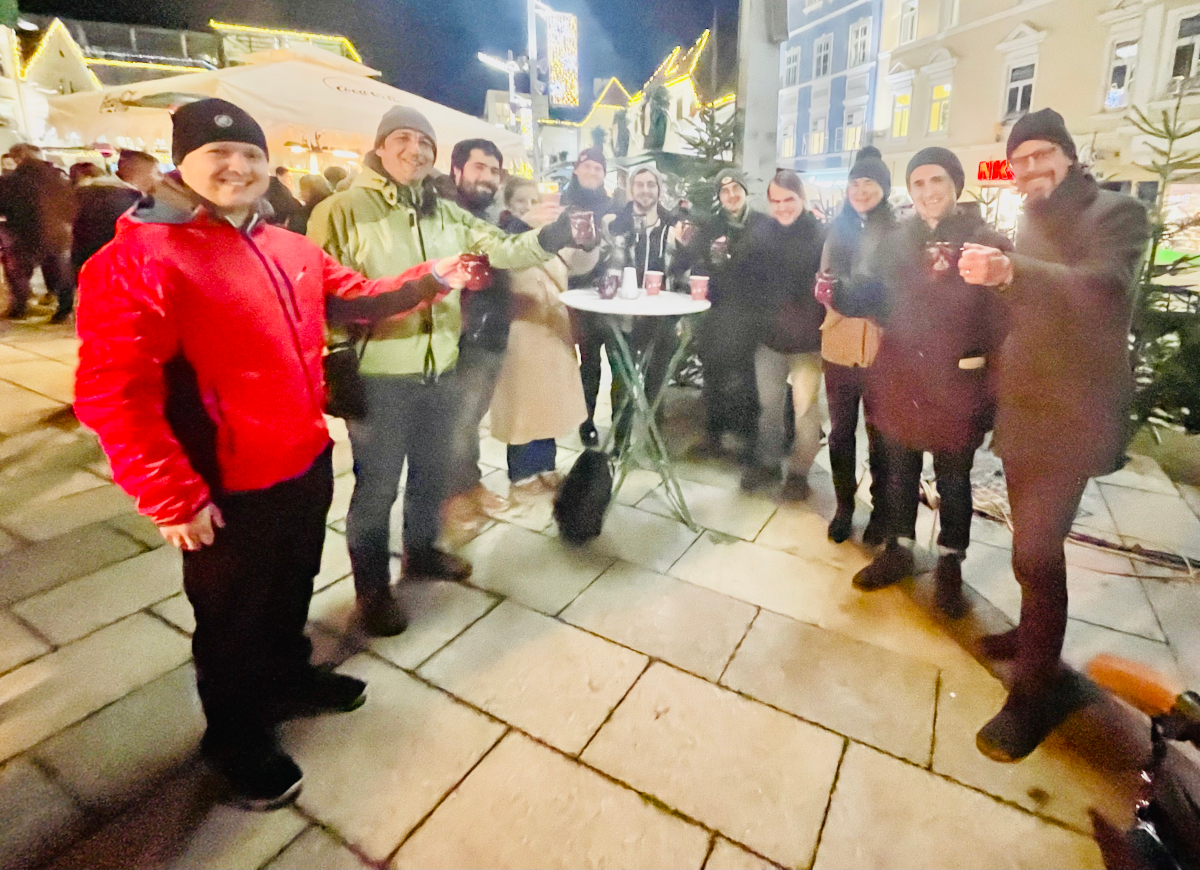
High-entropy materials have drawn lots of attention in the past decade. Typically the focus is laid on the stabilization via configurational entropy. In this publication, we show that equally important is the effect of the specific volume mismatch adding a strain-energy penalty to the overall decomposition energy balance. We have used DFT calculations to predict the stability of a massive number of hexinary nitrides (one sublattice in the B1 structure fully occupied by N while the other contains five elements with equal molar fractions). The theoretical predictions were confirmed by a dedicated experiment on PVD-synthesised thin films.
The work is a collaboration with the groups of Paul Mayrhofer (TU Wien), Jochen Schneider (RWTH Aachen) and the company Oerlikon Balzers.
A. Kretschmer, D. Holec, K. Yalamanchili, H. Rudigier, M. Hans, J. Schneider, P. Mayrhofer: "Strain-stabilized Al-containing high-entropy sublattice nitrides". Acta Mater., 224, 117483 (2022). DOI: 10.1016/j.actamat.2021.117483
Maximilan has presented his BSc thesis title “Graphene“ and thereby fulfilled all requirements of the BSc study program in “Materials Science“ at Montanuniversiät Leoben. The thesis was externally co-supervised by Dr. Rajarshi Roy.
Congratulations!
Martensitic transformation between bcc and hcp phases has been reported for the model TiAl+Mo alloy. Therefore, we have employed complementary DFT methods, namely VASP-SQS and EMTO-CPA, to report structural and mechanical properties of those phases as a function of Mo content. Discrepancies between the two employed ab initio methods in the case of the βo and B19 phases are rationalized with significant local distortions which may eventually facilitate a spontaneous phase transformation.
The work is a collaboration with the groups of Svea Mayer (MUL) and Jürgen Spitaler (MCL Leoben).
N. Abdoshahi, P. Spoerk-Erdely, M. Friák, S. Mayer, M. Šob, D. Holec: "Ab initio study of chemical disorder as an effective stabilizing mechanism of bcc-based TiAl+Mo". Phys. Rev. Materials, 4(10), 103604 (2020). DOI: 10.1103/PhysRevMaterials.4.103604
Tobias has successfully defended his MSc thesis on “Assessment of Various DFT-based Methods for Predicting Temperature Dependence of Elastic Constants“ and has passed with distinction the final exam to get an MSc degree in Materials Science.
Congratulations!
A review paper showing several examples of insights which can be obtained from DFT calculations, useful for alloy development.
D. Holec, N. Abdoshahi, D. Gehringer, L. Hatzenbichler, A. Sakic, H. Clemens: "Electrons meet alloy development: a γ-TiAl-based alloys showcase". Adv. Eng. Mater., (2021). DOI: 10.1002/adem.202100977
CHARM (Czech-Austrian colloquium on first-principles modelling of advanced materials) 2021 was the first in-person meeting after the Corona had effectively killed traditional scientific interaction. The meeting was hosted by Institute of Physics of Materials, Czech Academy of Sciences in Brno, Czech Republic, and we were able to enjoy many interesting and inspiring presentations and discussions. The Leoben's CMS group was presented by 4 talks by Neda Abdoshahi and Ganesh Nayak (WG Holec) and by Alexander Reichmann and Christoph Dösinger (WG Romaner).
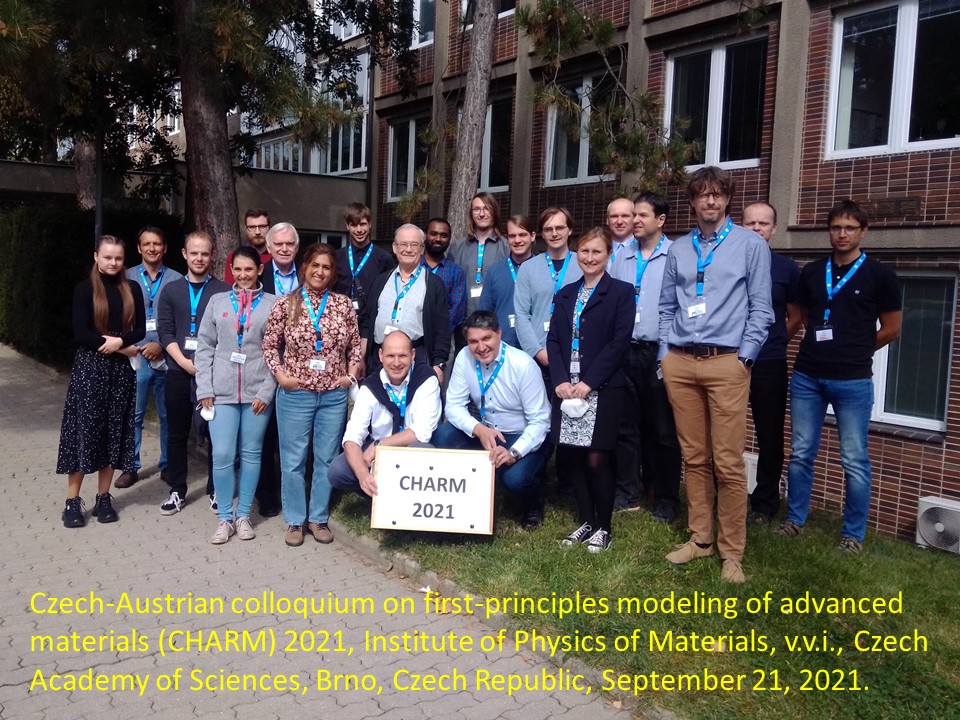
Two talks were delivered in the framework of the departmental seminar series "Materials Science Colloquium": in his talk titled “Chemical shift in W-B-C systems: experiments and modeling” Jaroslav Ženíšek (MU Brno, Czech Republic) reported about their modelling activities of XPS. Tomáš Záležák (IPM Brno, Czech Republic) presented an implementation of discrete dislocation dynamics simulations in a talk titled “Numerical modelling of high temperature deformation using 3D discrete dislocation dynamics”. The seminar was virtual.
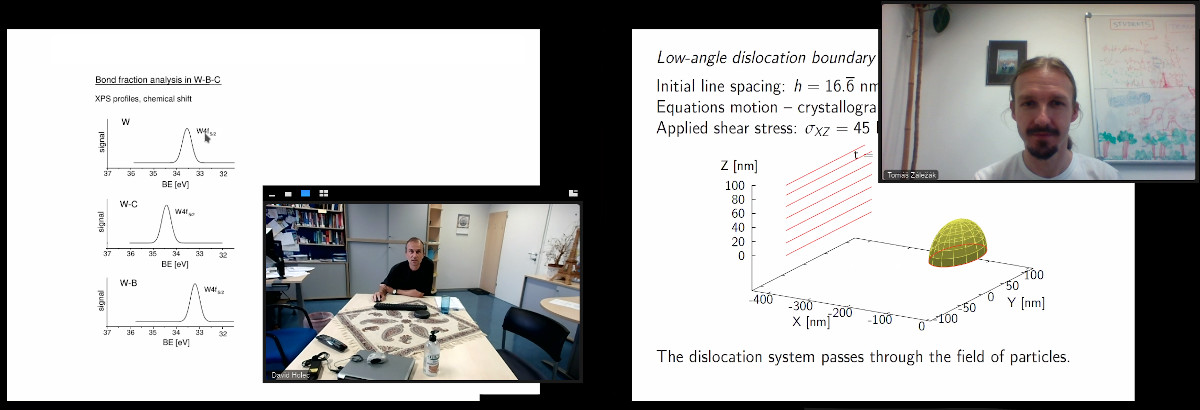
Neda has made the history: she is the first PhD student to finish within the CMS group! Her thesis “Ab initio study of martensitic and ordering transformations in intermetallic TiAl-alloys” was positively reviewed. Before passing the oral exam (held in person), Neda presented her thesis on a blackboard instead of a traditional slide presentation, again making history at MUL.
Congratulations!
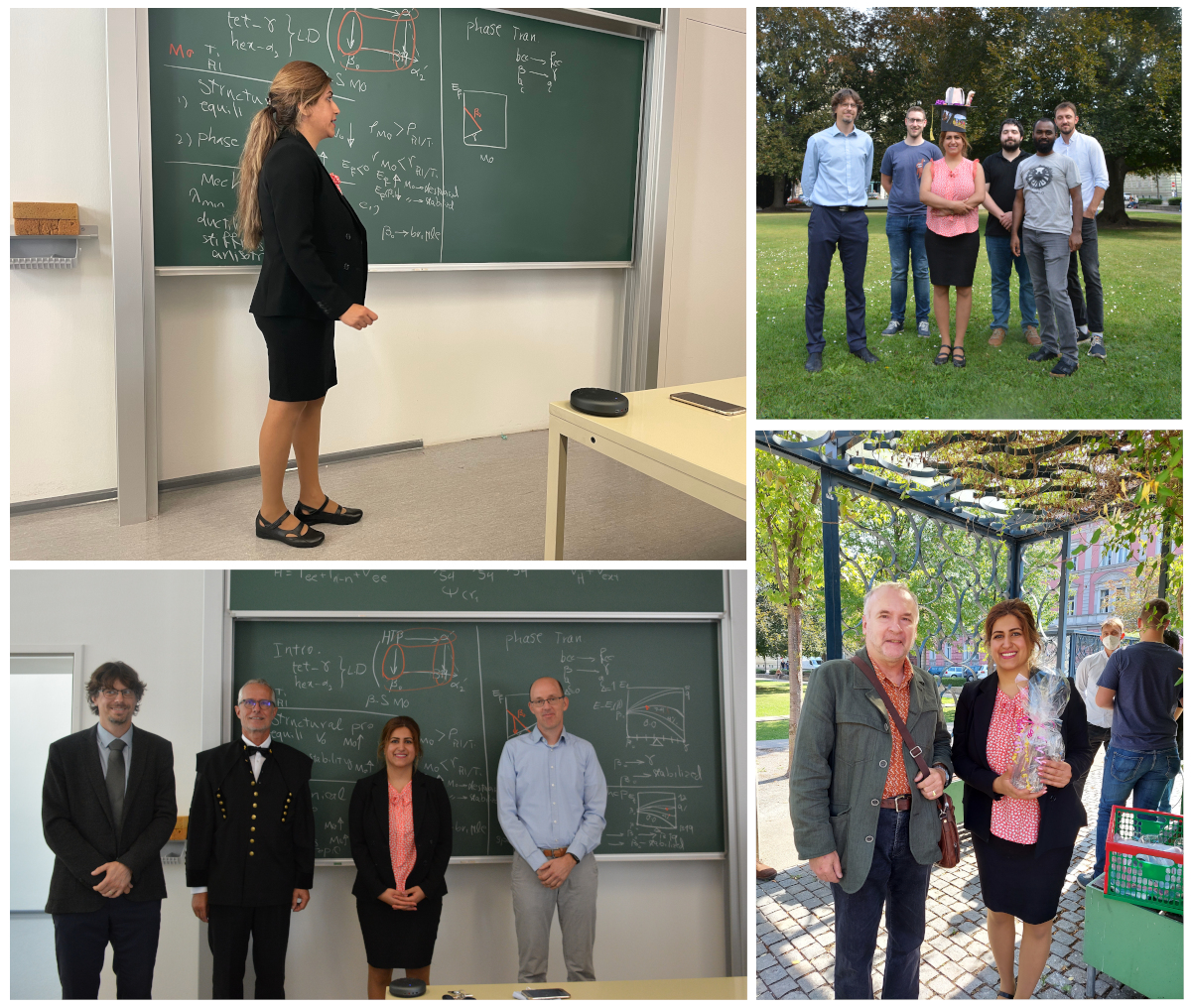
A primarily theory-based report aimed to answer several questions: is magnetism important for estimating the mechanical properties of CrN-based superlattices? Furthermore, can the computationally difficult paramagnetic state be simplified for modelling to a ferromagnetic state? Lastly, can the Grismditsch and Nizzoli method be used to predict mechanical properties of SL using mechanical properties of its constituents? In short, answers to all these questions are no. Magnetism has a necessary consequence for the structural properties of the superlattices, which are also mimicked in mechanical properties. Micromechanical experiments corroborate the theoretically predicted trends.
The work is a collaboration with the group of Paul Mayrhofer and Matthias Bartosik, TU Wien, Vienna, Austria.
L. Löfler, R. Hahn, P.H. Mayrhofer, M. Bartosik, D. Holec: "Mechanical properties of CrN-based superlattices: Impact of magnetism". Acta Mater., 218, 117095 (2021). DOI: 10.1016/j.actamat.2021.117095
This paper reports on enhanced thermal stability of TiAlON thin films as compared with TiAlN coatings. An extensive experiment analysis including also TEM and APT revealed differences in formation of the wurtzite AlN phase: while this happens inside the cubic grain in TiAlN, w-AlN was observed preferentially at grain boundaries in TiAlON. These differences were eventually linked to differences in diffusion processes: while the diffusion on only metal sublattice is sufficient for decomposition of TiAlN, non-metal species must also diffuse in the TiAlON case. The calculated diffusion barriers are significantly larger for the non-metal species than for the metals, hence hindering the non-metal species diffusion and eventually increasing the thermal stability of TiAlON.
The work is a collaboration with Jochen Schneider's group, RWTH Aachen, Germany.
D.M. Holzapfel, D. Music, M. Hans, S. Wolff-Goodrich, D. Holec, D. Bogdanovski, M. Arndt, A.O. Eriksson, K. Yalamanchili, D. Primetzhofer, C.H. Liebscher, J.M. Schneider: "Enhanced thermal stability of (Ti,Al)N coatings by oxygen incorporation". Acta Mater., 218, 117204 (2021). DOI: 10.1016/j.actamat.2021.117204
First principles calculations are used to calculate diffusion coefficients of Ti and V in TiN matrix. We could show that while the barriers for the interstitial diffusion are small than for a vacancy-mediated mechanism, the latter is a faster procedure leading to an overall larger diffusion coefficient. We have also considered impact of pressure on the diffusion, which was inspired by the realconditions in cutting and tooling applications. We have concluded that the pressure is much less significant than the temperature.
The work is a collaboration with Maxim Popov, MCL Leoben, Austria.
G. Nayak, M.N. Popov, D. Holec: "Pressure- and temperature-dependent diffusion from first-principles: A case study of V and Ti in a TiN matrix". Surf. Coat. Technol., 422, 127491 (2021). DOI: 10.1016/j.surfcoat.2021.127491
A second year of a small team-building activity. We started hiking from Präbichl around 7am and reached the summit shortly after 9.15am. Back in the offices around 1.30pm. More photos in 2021 photo gallery.

Jakob presented results of of his BSc thesis title “Impact of Control Parameters on Molecular Dynamics Simulations of Mechanical Tests”. The thesis contains also original results on tensile tests of TiN/AlN superlattices. The whole work was supervised by Lukas Läfler.
Congratulations on finishing the first stage of your studies and good luck with your MSc work!
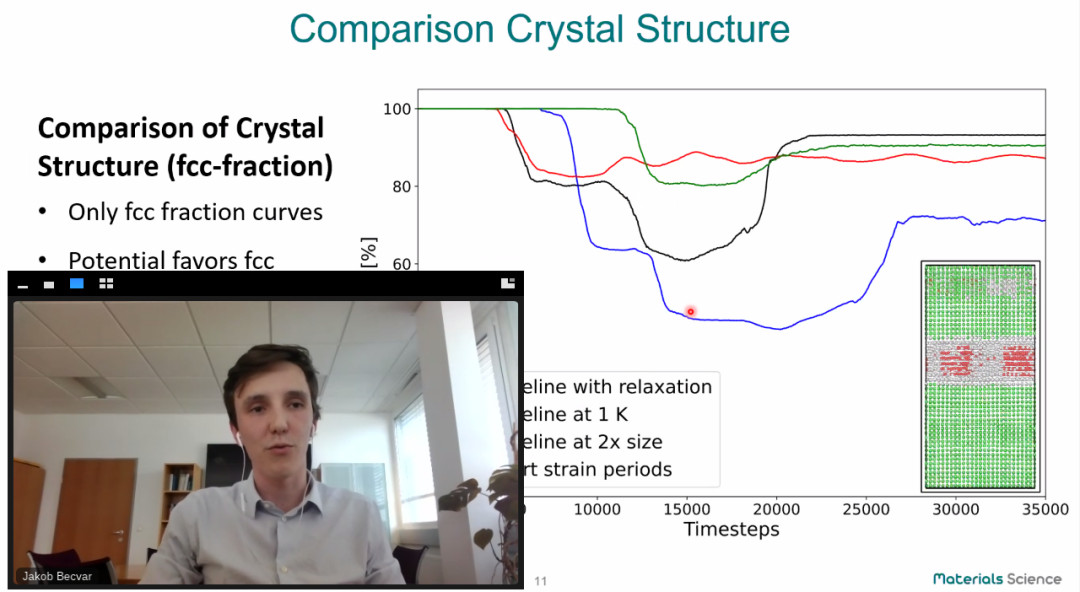
Thomas has successfully defended his MSc thesis on “Impact of the stacking sequence on the stability of transition-metal diborides“ and has passed the final exam to get an MSc degree in Materials Science.
Congratulations!
Imaging and analytical modes were used to investigate intermixing of AlN and TiN layers under the indentor tip. Our experimental colleagues could prove that while the cubic lattice (although severaly deformed) is maintained near the tip, Al and Ti metals became intermixed in the form of a TiAlN solid solution. This unique observation was corroborated by a virtual experiment using molecular dynamics, which also resulted into mixing of metallic species beyond a simple deformation-induced displacement. Employing density functional theory we also showed that pressure induced changes in diffusion barriers cannot alone explain the intermixing; other effect such as reduction of interface energy by removing the interfaces and reduction of dislocation density are equally important.
The work is a collaboration with the groups of Zaoli Zhang, ESI-OeAW, Leoben, Austria, and of Paul Mayrhofer and Matthias Bartosik, TU Wien, Vienna, Austria.
Z. Chen, Y. Zheng, L. Löfler, M. Bartosik, G. Nayak, O. Renk, D. Holec, P.H. Mayrhofer, Z. Zhang: "Atomic insights on intermixing of nanoscale nitride multilayer triggered by nanoindentation". Acta Mater., 214, 117004 (2021). DOI: 10.1016/j.actamat.2021.117004
Point defects are essential building blocks for tuning material properties. In this paper, we investigated (our well known :-) TiN synthesized using different bias voltages, leading to varying content of point defects. Analytical investigations using quantitative EELS measurements and XRD revealed compositions of individual coatings. Using DFT, we calculated the dependence of various mechanical properties on the defect concentration (vacancies, interstitials, anti-sites). We were able to correlate those with the measured mechanical properties via micromechanical tests. Thereby, we validated our structural models corresponding to the measured compositions.
The work is a collaboration with the groups of Zaoli Zhang, ESI-OeAW, Leoben, Austria, and of Paul Mayrhofer and Matthias Bartosik, TU Wien, Vienna, Austria.
Z. Zhang, A. Ghasemi, N. Koutná, Z. Xu, T. Grünstäudl, K. Song, D. Holec, Y. He, P.H. Mayrhofer, M. Bartosik: "Correlating point defects with mechanical properties in nanocrystalline TiN thin films". Mater. Des., 207, 109844 (2021). DOI: 10.1016/j.matdes.2021.109844
In this paper we introduce a concept based on a combination of atomistic modelling and continuum mechanics for a core–shell system. Considering crystalline and amorphous gold nanoparticles with radii in the range of 1 nm to 12 nm, we are finally able to independently calculate the values of surface stress and surface energy, both slightly decreasing with the increasing particle radius. Surprisingly large values of surface stress are predicted for the case of amorphous nanoparticles.
The work is a collaboration with the professors Franz Dieter Fischer (Leoben, Austria) and Dieter Vollath (Germany)
D. Holec, L. Löfler, G.A. Zickler, D. Vollath, F. Fischer: "Surface stress of gold nanoparticles revisited". Int. J. Solids Struct., 224, 111044 (2021). DOI: 10.1016/j.ijsolstr.2021.111044
Ulrich has presented content of his BSc thesis. Due to the circumstances, the presentation was online, nonetheless, it was fairly well attended with around 20 listeners in the audience (including guest outside of the Uni :-).
Congratulations on finishing the first stage of your studies!

A methodological error in our original paper (Phys. Rev. B 101, 125421 (2020)) regrettably led to an overestimation of the softening in bilayer graphene as compared with graphite. Moreover, inconsistencies in the numerical integration of charge have been corrected, now showing a much more physical picture of electron squeezing through the graphene layers. The corrected results do not qualitatively change the message. In addition to self-correcting our predictions, we have gained more insight into the evaluation of stresses in low-dimensional materials.
The work is a collaboration with the groups of Colin Humphreys and David Dunstan, Queen Mary University of London, London, UK.
Y.W. Sun, D. Holec, D. Gehringer, O. Fenwick, D.J. Dunstan, C.J. Humphreys: "Erratum: Unexpected softness of bilayer graphene and softening of A-A stacked graphene layers [Phys. Rev. B 101, 125421 (2020)]". Phys. Rev. B Condens. Matter, 103(11), 119901 (2021). DOI: 10.1103/PhysRevB.103.119901
In this paper, we present a model which accounts for lattice mismatch stress relaxation during growth by a subsequent introduction of misfit dislocations at the interfaces. The driving force for this process is the minimization of the overall elastic energy. In turn, these misfit dislocations contribute towards alternating compressive/tensile stress profile which introduces an additional barrier for a crack propagation on top of the intrinsic fracture toughness. This phenomenon, termed apparent fracture toughness, enabled rationalisation of experimentally reported enhancement of fracture toughness in CrN/TiN superlattices.
The work is a collaboration with the group of Paul Mayrhofer and Matthias Bartosik, TU Wien, Vienna, Austria.
A. Wagner, D. Holec, P.H. Mayrhofer, M. Bartosik: "Enhanced fracture toughness in ceramic superlattice thin films: On the role of coherency stresses and misfit dislocations". Materials and Design, 202 (2021). DOI: 10.1016/j.matdes.2021.109517
Using in-situ atomic-resolution electron microscopy, we report twin boundary migration mechanisms in rock-salt CrN. We show that coherent TB migration is associated with a boundary structure alternating from an N-terminated to Cr-terminated, involving Cr and N atom respective motion, i.e., asynchronous CTB migration. These observations are corroborated through strain analysis and DFT simulations which reveal the dynamic and thermodynamic mechanism of such asynchronous migration.
The work is a collaboration with the group of Zaoli Zhang, ESI-OeAW, Leoben, Austria.
Z. Chen, Y. Zheng, L. Löfler, M. Bartosik, H. Sheng, C. Gammer, D. Holec, Z. Zhang: "Real-time atomic-resolution observation of coherent twin boundary migration in CrN". Acta Mater., 208, 116732 (2021). DOI: 10.1016/j.actamat.2021.116732
MoN and TaN can be stabilized in cubic structures, however, not with a stoichiometric composition. While MoN prefers N vacancies, TaN likes metallic vacancies. In this study, we probe experimentally and theoretically the interplay between amount and type of point defects and the resulting microstructure. It turns out that modifying N partial pressure during a PVD deposition can prefer either N vacancies (low N partial pressures) or metal vacancies (high N partial pressure). In the latter case, the cubic phase tends to co-exist with a hexagonal phase, which strongly impacts the overall mechanical properties.
The work is a collaboration with the group of Paul Mayrhofer, TU Wien, Vienna, Austria.
F.F. Klimashin, L. Lobmaier, N. Koutná, D. Holec, P.H. Mayrhofer: "The MoN–TaN system: Role of vacancies in phase stability and mechanical properties". Mater. Des., 202, 109568 (2021). DOI: 10.1016/j.matdes.2021.109568
In the framework of the departmental seminar series "Materials Science Colloquium", Marcus Hans (RWTH Aachen, Germany) has presented selected examples of the application of atom probe tomography to study the thermal stability of hard coatings. The selected applications included VAlN and two examples of high-entropy on metal sublattice (HEM) coatings: HEMN and HEMB2. The virtual seminar was attended also by our guests from TU Wien and from RWTH Aachen, with over 40 participants.

First principle calculations are utilized to probe different combinations of nitrites and carbides to form superlattices. Those are characterized with respect to their chemical and mechanical stability and mechanical properties. Additionally, also impact of point defects (vacancies) is discussed. We then apply several selection criteria to propose potentially interesting material combinations with improved ductility and fracture resistance. Among the "usual suspects" such as MoN/TaN or TiN/WN we newly propose several combinations (e.g. NbC/MoN, TaX/WN or VC/HfN) which are worth testing experimentally.
The work is a collaboration with the group of Paul Mayrhofer, TU Wien, Vienna, Austria.
N. Koutná, A. Brenner, D. Holec, P.H. Mayrhofer: "High-throughput first-principles search for ceramic superlattices with improved ductility and fracture resistance". Acta Mater., 206, 116615 (2021). DOI: 10.1016/j.actamat.2020.116615
As a part of the departmental seminar series "Materials Science Colloquium", Martin has presented summary of his work from the past 5 years focusing on ab initio investigations of intriguing interplay between local chemistry, magnetism and thermodynamics of anti-phase boundaries in FeAl intermetallics. Due to the present situation, the seminar was virtual, but still with a decent attendance.
